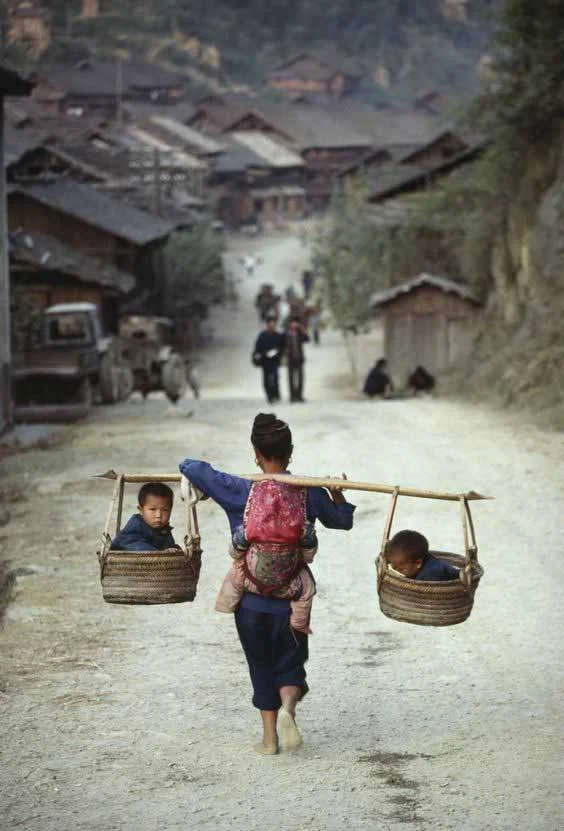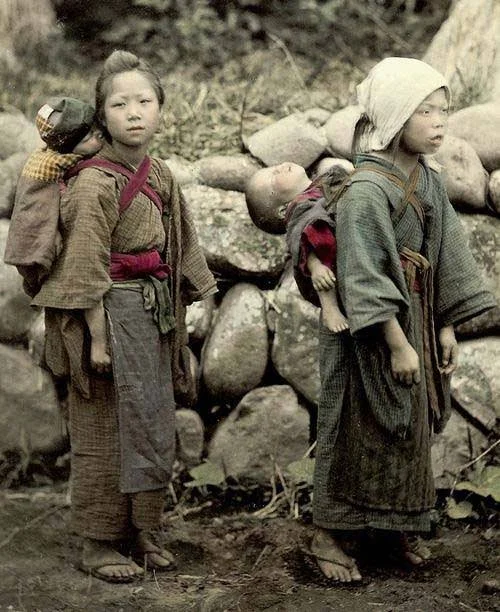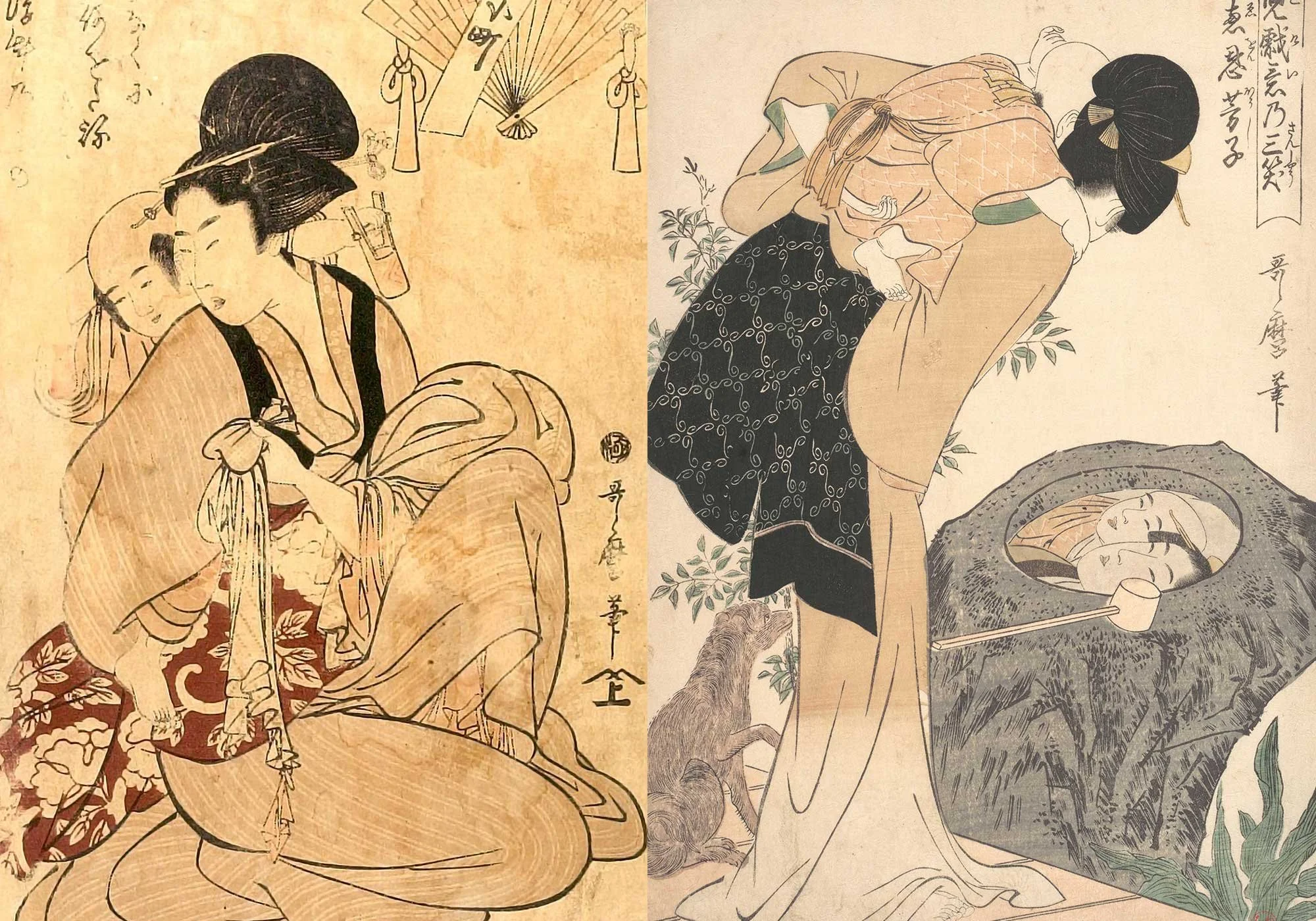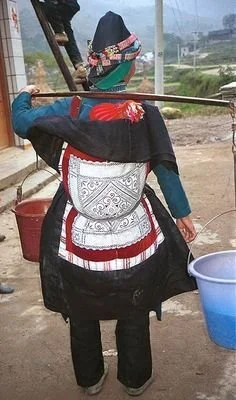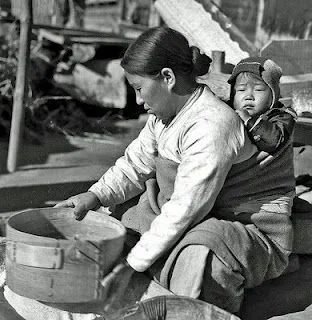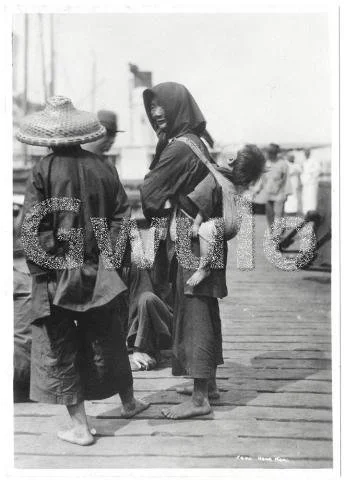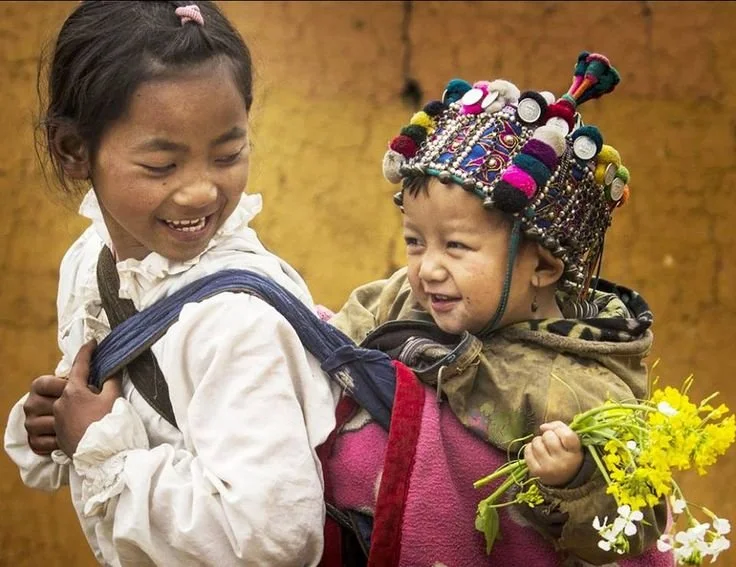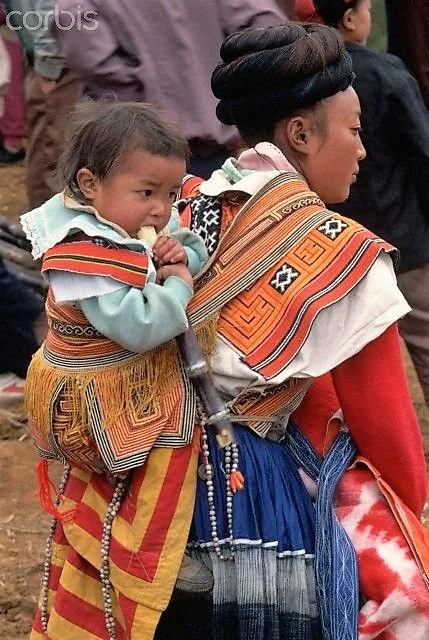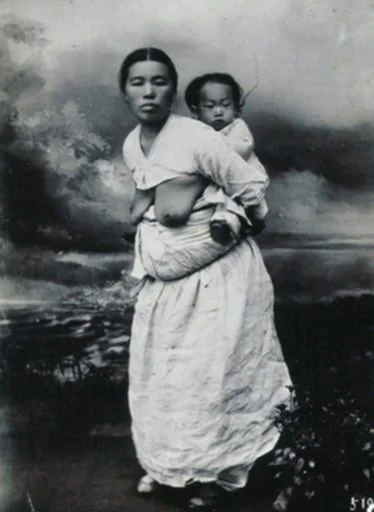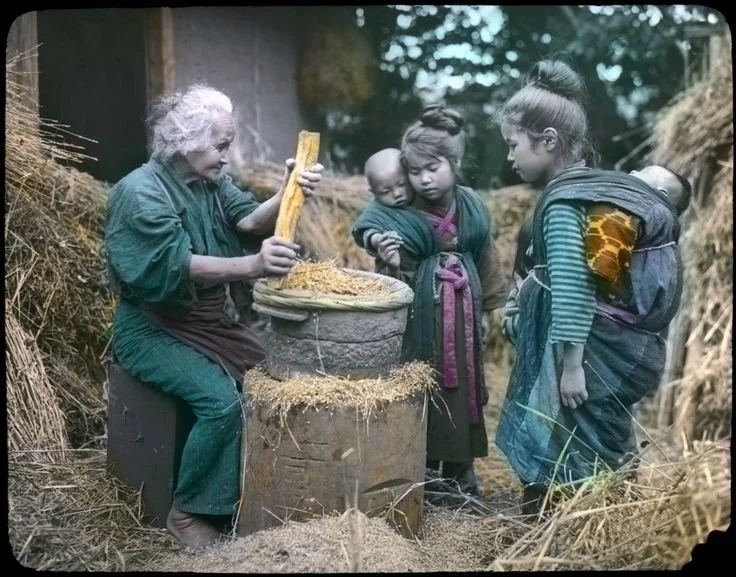East Asia: Knotted in Silk and Memory
Across East Asia — including China, Japan, and Korea — babywearing traditions are beautifully woven into daily life, textile art, and the rhythms of close-knit family communities. Each region offers unique styles and deep cultural meanings, yet all share the central value of keeping babies close, safe, and included in every moment.
In China, the Meh Dai (also spelled Mei Tai) is a classic example of ingenuity and simplicity. This traditional carrier uses a rectangular body panel with long straps that are tied around the caregiver’s waist and shoulders, securing the baby snugly to the front or back. The Meh Dai supports healthy hip positioning and allows for flexibility in daily tasks — from cooking to working in markets or fields. These carriers were often handmade, sometimes beautifully embroidered, reflecting family identity and regional artistry.
China
This beautiful, modern black-and-white photograph shows a mother wearing her baby on her back in a mei tai (or bei dai) style carrier while preparing food in the kitchen.
The mei tai (北带 / 背带), originating in China, is a traditional Asian-style carrier that has been adapted worldwide. It uses a panel of fabric with long straps to create a secure, supportive seat for the baby. In this image, the baby is comfortably asleep, their head resting gently on the mother’s back — a testament to the closeness and security this method provides.
The mother's hands are free to chop and cook, demonstrating how babywearing can beautifully integrate caregiving and daily tasks. This photograph captures the enduring balance of nurture and work that parents everywhere know so well.
China
In this evocative photograph, a mother in rural China carries her three young children using traditional methods that beautifully blend care and practicality. Two children sit calmly in large woven baskets balanced on either end of a wooden shoulder pole — known locally as a dan or bian dan — while a third child is carried snugly on her back in a cloth carrier.
Walking barefoot along a village road, she moves steadily, embodying both strength and tenderness. This ingenious carrying technique, deeply rooted in Chinese and Southeast Asian traditions, distributes heavy loads evenly and allows mothers to continue daily work while keeping children close and engaged in the flow of village life.
The baskets, crafted from natural materials, speak to resourcefulness and skill passed down through generations. This image is a powerful testament to the creativity and resilience of mothers everywhere, illustrating how parenting is seamlessly interwoven with everyday survival and community life.
Japan
These children are from Japan, their layered kimono-style clothing, woven straw sandals, and the style of the hand-tinted photograph, which was popular in Japan in the late 19th and early 20th centuries. They are carrying younger children on their backs in a traditional style known as onbuhimo. While the carriers in this image resemble a Chinese meh dai (mei tai) because of their panel shape and strap arrangement, the onbuhimo is a distinctly Japanese carrier that ties over the shoulders and around the body. Historically, some onbuhimo included wider cloth panels or additional ties under the child’s bottom, which can make them appear similar to a meh dai in old photographs. This image beautifully illustrates how older siblings and caregivers played a role in babywearing across cultures, and how carrier designs share structural echoes across East Asia while remaining deeply rooted in local traditions.
In Japan, the onbuhimo is a unique and elegant carrier without a waistband. Traditionally used for older babies and toddlers, the onbuhimo positions the child high on the caregiver’s back, allowing them to see over shoulders and stay engaged with the world around them. This style reflects Japanese cultural values of observation and shared experience, enabling children to learn through quiet, close immersion in daily life.
These elegant Japanese woodblock prints by Kitagawa Utamaro capture mothers carrying their babies on their backs in a style known as onbuhimo. The images beautifully illustrate the intimacy and grace of traditional Japanese babywearing, where a simple cloth or sash secures the child high on the mother’s back, allowing her to work or move about while keeping her baby close. The babies often peek over the mother’s shoulder, observing the world in comfort and safety. These tender scenes remind us that across time and culture, carrying children in close contact has always been a way to nurture connection, warmth, and trust — a practice as practical as it is profoundly human.
In Korea, the podaegi features a large blanket-like panel with long straps, allowing versatile tying methods. This design provides secure support while distributing weight comfortably across the caregiver’s body. Often crafted from vibrant, beautifully patterned fabrics, the podaegi embodies warmth and family closeness, and continues to be used both in traditional and modern contexts.
China
In this striking photograph, a mother from a rural region of China skillfully balances her daily work and caregiving in perfect harmony. With her baby carried securely on her back in a woven cloth carrier, she uses a traditional bamboo shoulder pole (known as a dan or bian dan) to carry two heavy red buckets of water or goods.
Across East Asia, babywearing practices have historically been passed down through generations, taught by grandmothers and aunties through demonstration rather than written record. These methods emphasize communal care, patience, and the deep-rooted belief that babies thrive when wrapped in love and shared life.
Though modernization and Western parenting ideals have influenced urban areas, many families continue to honor and revive these traditions today. Reclaimed and celebrated, these carriers speak to the quiet strength and artistry of East Asian cultures.
To be carried in East Asia is to be wrapped in silk and memory, to feel each knot as a promise of safety and belonging, and to be folded into a living story of family and community.
Miao - China
This striking photo shows a Miao mother in China carrying her baby in a traditional nyia, or Hmong-style baby carrier, while skillfully balancing two buckets on a carrying pole. The carrier’s intricate, hand-embroidered panel — rich with protective and symbolic motifs — showcases the extraordinary textile craftsmanship passed down through generations. Babywearing here makes it possible for her to keep her little one close and safe, even while completing physically demanding tasks. The colorful clothing and bold headwear reflect her cultural pride and identity, reminding us that babywearing is not only a practical necessity but a living expression of love, resilience, and deep-rooted tradition."
Korea
This powerful historical photograph shows a Korean mother carrying her child on her back in a traditional podaegi, a wide blanket-style carrier used for generations. The podaegi wraps snugly around both mother and child, keeping the baby high and close while leaving her arms free for work. Here, she prepares food, embodying the quiet strength and resourcefulness of mothers everywhere. The baby, safe and content, observes the world from the warmth of her back. This image beautifully captures the essence of babywearing as an intimate, practical act of love woven into everyday life."
Japan
This exquisite historical image from Japan shows two young girls, each carrying a baby on their back using a traditional onbuhimo — a simple, sash-style Japanese baby carrier. Dressed in beautiful kimono with wide obi sashes, the girls stand gracefully, one holding a delicate paper umbrella. The babies ride high on their backs, secure and close, able to look around and share in the day’s experiences. This image not only illustrates the elegance and practicality of babywearing in Japanese culture but also highlights the role of older siblings in caring for younger family members. Every detail, from the clothing to the backdrop of Mt. Fuji, speaks to a deep cultural heritage where connection, responsibility, and beauty intertwine.
Hong Kong
This historical image from Hong Kong shows a mother carrying her baby on her back in a traditional mei tai (also called a bei dai). This simple yet beautifully practical carrier — a rectangular cloth panel with long straps — is tied snugly to keep the baby safe and close while she goes about her day. The mei tai reflects a deep cultural value of staying connected, making it possible for little ones to rest, feed, and watch the world from the warmth of their mother’s back. This image captures not just a way of carrying, but a quiet story of love and belonging woven into daily life.
Naxi - China
This image captures a woman of the Naxi people, an ethnic group from the Yunnan province of southwestern China, carrying a baby in a traditional back carrier. The Naxi are known for their rich textile arts and distinctive dress, including elaborate headdresses and embroidered garments. The brightly colored, cross-tied carrier keeps the child secure and close, allowing the caregiver to move freely through daily tasks and mountainous terrain. Babywearing among the Naxi not only reflects practicality but also conveys cultural pride and the intergenerational transmission of knowledge, warmth, and connection.
China
In the mountains of southwestern China, among groups like the Miao, Hani, and Yao, babywearing is an integral thread in the fabric of daily life. Siblings often help carry younger children, strengthening bonds of care and responsibility from an early age. Elaborately embroidered carriers, adorned with coins, pompoms, and protective charms, reflect each family's artistry and hopes for the child's wellbeing. Being carried in these vibrant cloths means being immersed in laughter, stories, and the warmth of communal life — a joyful dance of tradition and love that connects each child to their ancestors and the land around them.
Hmong - China
In the mountainous regions of southern China and northern Vietnam, among groups such as the Hmong and other ethnic minorities, beautifully embroidered baby carriers — often adorned with vivid colors, floral motifs, and protective symbols — reflect both artistry and care. Babies are secured high on the caregiver's back, allowing them to observe and be part of daily life from a young age. The embroidery is not only decorative but also carries blessings and wishes for the child’s safety and well-being. To be carried this way is to feel the steady rhythm of a parent’s steps and to grow up immersed in the textures and stories woven into each stitch.
Korea
In rural Korea, traditional babywearing has long been practiced using a po, a large square cloth often tied around the mother’s waist and shoulders. This simple yet secure method keeps the baby close to the caregiver’s back, allowing her to continue farming, preparing food, or tending the home. The connection maintained through constant physical closeness reflects deep-rooted values of family and interdependence in Korean culture. Even today, this practice symbolizes the enduring bonds between mother and child and highlights the adaptability of traditional caregiving methods in daily life.
China
In this photo, we see a grandmother carrying a baby on her back using a traditional meh dai, a style widely used among many hill tribe groups in southern China. The rectangular embroidered panel supports the child, while the long woven straps wrap around the caregiver’s shoulders and waist to secure the baby snugly against her back. This upright, close-carry position allows caregivers to continue daily activities and care for other children while keeping babies safe and connected. The colorful, handwoven textiles reflect regional identity and family heritage, making each carrier unique and deeply meaningful.
Yi - China
A mother from the Yi ethnic group in southwest China carries her child in a beautifully decorated traditional carrier. The intricate geometric embroidery and bright fringed details of the carrier mirror the ornate patterns of her clothing, showcasing the community’s rich textile heritage and skilled craftsmanship. The child rests securely on her back, snuggled close while observing the lively surroundings, perhaps at a local market or festival. The mother’s elaborate hair arrangement and layered garments further highlight cultural pride and identity, illustrating how babywearing here is deeply woven into daily life, tradition, and artistic expression.
Japan
This artwork depicts Japanese women wearing traditional dress, including kimono and head coverings, in a scene of everyday life. One woman is shown carrying a baby on her back using a simple cloth wrap, a traditional practice known in Japan as onbuhimo. This carrying style, with the baby high on the back and secured close to the caregiver’s body, allows the wearer to move freely and continue daily tasks while maintaining intimate contact. The soft cloth, tied around the shoulders and waist, is practical and deeply woven into the rhythms of Japanese life, reflecting the enduring value of closeness and connection between mother and child.
Korea
This early 20th-century studio portrait from Korea (circa 1900–1920) shows a mother carrying her baby in a traditional podaegi — a wide cloth wrap used to secure little ones safely on the caregiver’s back. Dressed in simple white hanbok, her chest remains open for easy breastfeeding, reminding us how feeding and carrying were seamlessly woven into everyday life. While the painted studio backdrop hints at formality, the quiet connection between mother and child shines through. This image invites us to honour the long, unbroken thread of Korean babywearing traditions, where closeness, nourishment, and care have always gone hand in hand.
Japan
In this beautifully hand-colored historical photograph from Japan, we see an intergenerational scene full of quiet connection and daily life. An elderly woman works diligently at a traditional rice or grain grinder, her hands skillfully turning the wooden pestle. Beside her, two young women (perhaps daughters or daughters-in-law) each carry a baby on their back, and a child stands watching attentively.
The babies are carried snugly in traditional onbuhimo style carriers — wide cloth wraps that secure children high on the caregiver’s back, allowing them to look out and stay fully involved in family life. In Japanese tradition, these carriers enabled women to continue agricultural or household work while keeping babies close and comforted.
A note of gratitude and respect
We respectfully acknowledge and honor the individuals and communities depicted in historical images throughout this series. Many of these photographs were taken in times and contexts where informed consent as we understand it today was not sought or given, and some may have been created through coercion or exploitation.
We share these images with the deepest gratitude, not to romanticize or objectify, but to recognize and celebrate the strength, resilience, and wisdom of these cultural practices. We hold these ancestors and knowledge holders in our hearts and aim to represent their traditions with integrity, humility, and care.
We commit to continuing to learn, listen, and uplift the voices of contemporary community members and descendants, and we welcome guidance on the respectful sharing of these images.


